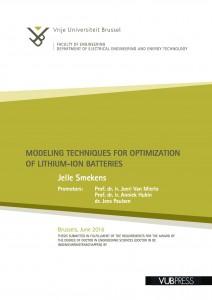
The objective of this research was to aid in the development of advanced Lithium-Ion batteries for (hybrid) electric vehicles. Over the last two decades, battery industry has established large, highly effective R&D labs where high throughput experiments are used to investigate new materials, manufacturing process parameters and alternated cell designs (i.e. geometrical cell parameters). The main reason for this costly and time consuming approach is the inability to accurately predict dynamic cell performance and estimate the effect of new active and passive materials. Indeed, maximum available capacity and equilibrium potential of a cell with known electrode materials are easily calculated, however energy density, power density and lifetime performance are dif cult to determine.
In many other engineering elds physics-based models are used in the product design phase. Furthermore the use of virtual design tools speed up the successful implementation of new materials in existing products because they allow a level of abstraction describing materials in terms of most relevant intrinsic material properties. First steps towards practical battery models have been made but the successful use of battery simulation tools in industry lags behind. Certain critical aspects of battery modeling have not yet adequately been studied mainly because of the complex nature of the porous electrodes to which a Li-Ion battery cell owes its superior performance.
In this work a rigorous physics-based model for lithium nickel manganese cobalt oxide versus graphite based cells is developed that can estimate current-voltage response, energy and power capacity, and ohmic resistance. The model describes the behavior as a function of material and design parameters making it possible to design a battery starting from the required performance. The model can be extended to other intercalation compounds and porous electrodes.
This thesis presents a state-of-the art methodology to simulate battery performance based on the most important cell design parameters.
